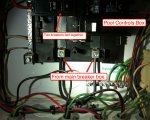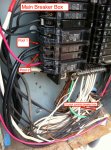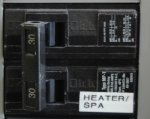All,
An electrician came out and worked on my main breaker box installing two new circuits. The next day I found my pool pump no longer turns on. I hear the relay click but there is no noise from the pump at all. He claims he didn't do anything that would effect the pool but nothing else has changed on an otherwise stable configuration. My config:
- Goldline Pro Logic (PL-PS-8) with Hayward 1/3 hp pump (label says 230/115v).
- Main breaker box has two breakers that go to the pool control box
- Measuring breaker 1 to ground shows 120v, same for breaker 2
- Inside the pool control box there are two blacks coming in each read 120v to ground. To each other there is nothing.
Any idea what might have changed? The electrician claims whatever he did should not effect the pool. The only thing I can think of is the pool is suppose to be getting 240v but something changed and it isn't. But then again I have no idea how to check if this is the case.
At any rate if he can't figure it out tomorrow I am going to have him call a pool guy on his dime!
Thanks in advance.
An electrician came out and worked on my main breaker box installing two new circuits. The next day I found my pool pump no longer turns on. I hear the relay click but there is no noise from the pump at all. He claims he didn't do anything that would effect the pool but nothing else has changed on an otherwise stable configuration. My config:
- Goldline Pro Logic (PL-PS-8) with Hayward 1/3 hp pump (label says 230/115v).
- Main breaker box has two breakers that go to the pool control box
- Measuring breaker 1 to ground shows 120v, same for breaker 2
- Inside the pool control box there are two blacks coming in each read 120v to ground. To each other there is nothing.
Any idea what might have changed? The electrician claims whatever he did should not effect the pool. The only thing I can think of is the pool is suppose to be getting 240v but something changed and it isn't. But then again I have no idea how to check if this is the case.
At any rate if he can't figure it out tomorrow I am going to have him call a pool guy on his dime!
Thanks in advance.





